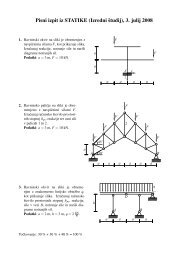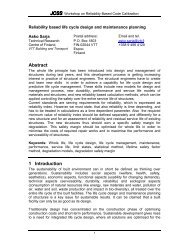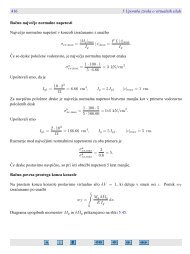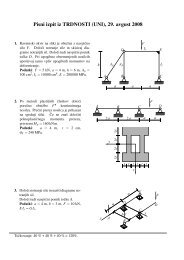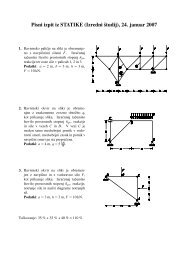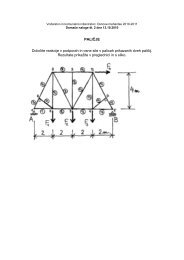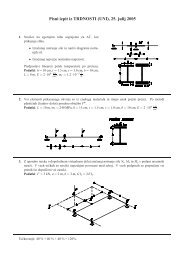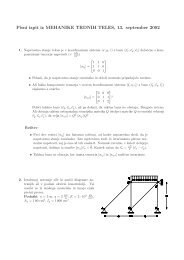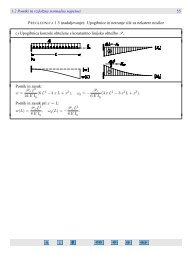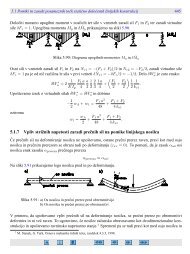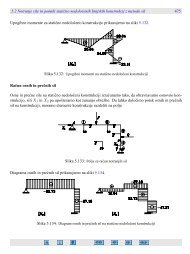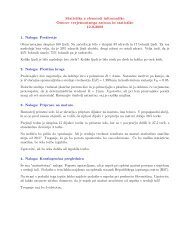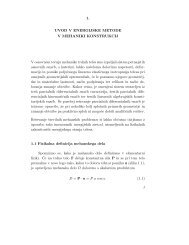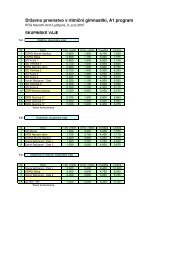X - FGG-KM
X - FGG-KM
X - FGG-KM
You also want an ePaper? Increase the reach of your titles
YUMPU automatically turns print PDFs into web optimized ePapers that Google loves.
JCSS Workshop on Reliability Based Code Calibration<br />
Zurich, March 2002<br />
Reliability-Based Code<br />
Calibration for Earthquake-<br />
Resistant Design<br />
Christiana Dymiotis<br />
Department of Civil & Offshore Engineering
Presentation overview<br />
Basic EC8 requirements and limit states<br />
Uncertainties in structural behaviour<br />
Code calibration at member level<br />
Structural vulnerability and seismic risk (SLS<br />
and ULS considerations)<br />
Calibration of behaviour factors<br />
Conclusions
Eurocode 8 (EC8) design<br />
No collapse requirement: the structure must be able to<br />
withstand the design seismic action without partial or total<br />
collapse so that structural integrity and a residual loadbearing<br />
capacity are retained following the earthquake.<br />
Damage limitation requirement: the structure must be able<br />
to withstand a seismic action that has a shorter return<br />
period than the design seismic action (i.e. higher<br />
probability of occurrence), so that the damage sustained<br />
does not impose any limitations on structural usage.
Eurocode 8 (EC8) design<br />
3 limit states<br />
• Serviceability limit state (SLS): no structural damage<br />
due earthquakes of low intensity.<br />
• Ulitmate limit state (ULS): only light and repairable<br />
damage due to earthquakes of moderate intensity.<br />
• Collapse limit state: no collapse due to earthquakes of<br />
high intensity.<br />
Capacity design approach<br />
• energy dissipation through large, inelastic deformations<br />
• strong column - weak beam design
Uncertainty at different levels<br />
Material<br />
behaviour<br />
f cc<br />
σ<br />
Section<br />
behaviour<br />
µ ϕ<br />
ν<br />
ε cu<br />
ε<br />
Structural<br />
behaviour<br />
h<br />
Member<br />
behaviour<br />
Μ<br />
∆x i<br />
/h i<br />
θ<br />
STRUCTURAL RELIABILITY
Investigated structural systems<br />
10×3m<br />
6m<br />
4m<br />
6m<br />
Bare frame<br />
(EC8-designed,<br />
DC“M”, A d =0.25g)<br />
Fully infilled<br />
frame<br />
“Pilotis” frame<br />
(soft ground storey)
Investigated cross-sections<br />
sections<br />
6Ø8<br />
162<br />
9Ø16<br />
6Ø8<br />
114<br />
8Ø12<br />
B250×850<br />
850 762<br />
Ø5/110<br />
250<br />
700 614<br />
Ø4/85<br />
200<br />
B200×700<br />
12Ø20<br />
Ø10/110<br />
8Ø16<br />
Ø6/80<br />
500<br />
398<br />
300<br />
212<br />
C500×500<br />
500<br />
300<br />
C300×300
Random variables<br />
Variable Mean COV (%) Distribution<br />
f c 28MPa 18 Normal<br />
X m,εcu 1.0 39 Normal<br />
f y 440MPa 6 Normal<br />
f u 506MPa 6 Normal<br />
ε su 0.09 9 Normal<br />
ULS: δ cr 6.6% 31 Lognormal<br />
(+ 2 additional lognormal variables for infilled frames)
Uncertainty in member capacity<br />
N<br />
Nc<br />
Strength<br />
response<br />
µ ϕ<br />
µ ϕ,1<br />
Ductility<br />
response<br />
Nb<br />
Nt<br />
M0<br />
Mb<br />
M<br />
µ ϕ,2<br />
ν 1 ν 2<br />
ν<br />
Fibre model approach - unit mean ratio of experimental to analytical<br />
values, COV≈7%<br />
Enhancement in strength and ductility due to confinement considered<br />
Ductility estimated based on various criteria for estimation of ε cu
Response Surface Method<br />
Identification of random variables<br />
Simple expressions for estimation of strength and ductility<br />
parameters (based on 2 nd order regression models)<br />
Very good agreement with fibre model values for sections<br />
not considered in derivation<br />
e.g. for column curvature ductility,<br />
ν=N/N ult =0.2<br />
( )<br />
2<br />
+ 0.02 fˆ<br />
− 0.06 fˆ<br />
0.01fˆ<br />
µ ϕ µ X +<br />
= ϕ<br />
m 1 c y c<br />
RSM<br />
15<br />
10<br />
5<br />
where X m =model uncertainty factor<br />
µ ϕ =fibre model prediction corresponding<br />
to mean values<br />
0<br />
0 5 10 15<br />
Fibre Model
Column flexural strength<br />
N (MN)<br />
4<br />
ε<br />
=<br />
3 ε<br />
2<br />
300×300mm Column<br />
cu<br />
sy<br />
⎛ d − x<br />
⎜<br />
⎝ xu<br />
y<br />
⎞<br />
⎟<br />
⎠<br />
12<br />
9<br />
6<br />
500×500mm Column<br />
EC2<br />
Fibre model -<br />
characteristic values<br />
Fibre model -<br />
mean values<br />
µ ϕ<br />
⎟<br />
⎠<br />
⎞<br />
1<br />
µ 0 ε cu ⎛ 0.60 − 0.50ν<br />
= ⎜<br />
ϕ ε ⎝ 1. 35 ν<br />
-1<br />
0 0.06 0.12 0.18<br />
sy<br />
3<br />
0<br />
-3<br />
M (MNm)<br />
0 0.2 0.4 0.6 0.8<br />
EC2 models lead to conservative strength estimates<br />
Higher safety margins above balance point
Shear strength<br />
Overall member shear capacity: V R3 =V c +V w<br />
Assessment: V c =V c1 +V c2<br />
• RSM function for V c2 , empirical functions for V c1 , V w<br />
Design: V c =V R1 (EC2)<br />
Simulated / Code values<br />
V R3, 0.05 / V R3, k V R3, 0.5 / V R3, m<br />
C300×300 1.74 1.97<br />
C500×500 1.55 1.82
Column curvature ductility<br />
Exact EC8 equation:<br />
ε ⎛ d − x ⎞<br />
cu y<br />
µ ϕ =<br />
⎜<br />
⎟<br />
ε sy ⎝ xu<br />
⎠<br />
µ ε cu ⎛ 0.60 − 0.50ν<br />
⎞<br />
= ⎜<br />
⎟ ϕ ε ⎝ 1. 35 ν ⎠<br />
Approximate EC8<br />
equation:<br />
sy<br />
300×300mm Column 500×500mm Column<br />
frequency<br />
30<br />
20<br />
N/N ult =0.1 30<br />
20<br />
10<br />
10<br />
0<br />
0<br />
0 15 30 45 0 15 30 45<br />
30<br />
N/N ult =0.2 30<br />
20<br />
20<br />
10<br />
10<br />
0<br />
0<br />
0 15 30 45 0 15 30 45<br />
µ ϕ<br />
µ ϕ<br />
Distributions corresponding to buckling or 0.85fc<br />
15<br />
Distributions 10 corresponding to buckling or 0.5fcc<br />
5<br />
Exact EC8 equation, characteristic material properties<br />
0<br />
1 2 3<br />
Approximate EC8 equation, characteristic material properties
Column curvature ductility<br />
Exact EC8 equation:<br />
ε ⎛ d − x ⎞<br />
cu y<br />
µ ϕ =<br />
⎜<br />
⎟<br />
ε sy ⎝ xu<br />
⎠<br />
µ ε cu ⎛ 0.60 − 0.50ν<br />
⎞<br />
= ⎜<br />
⎟ ϕ ε ⎝ 1. 35 ν ⎠<br />
Approximate EC8<br />
equation:<br />
sy<br />
300×300mm Column 500×500mm Column<br />
frequency<br />
30<br />
20<br />
N/N ult =0.1 30<br />
20<br />
10<br />
10<br />
0<br />
0<br />
0 15 30 45 0 15 30 45<br />
30<br />
N/N ult =0.2 30<br />
20<br />
20<br />
10<br />
10<br />
0<br />
0<br />
0 15 30 45 0 15 30 45<br />
µ ϕ<br />
µ ϕ<br />
15<br />
10<br />
5<br />
Distributions corresponding to buckling or 0.85fc<br />
Distributions corresponding to buckling or 0.5fcc<br />
Exact EC8 equation, mean material properties<br />
0<br />
1 2 3<br />
Approximate EC8 equation, mean material properties
Column curvature ductility<br />
Distributions<br />
corresponding to 0.85fc<br />
Distributions<br />
corresponding to 0.5fcc<br />
ν d ν µ m µ k,0.05 P(µ≤9) µ m µ k,0.05 P(µ≤9)<br />
C300×300 0.107 0.0465 15.12 5.71 0.14 24.86 8.97 0.05<br />
C500×500 0.526 0.215 9.21 3.67 0.48 13.77 5.65 0.17
Methodology for probabilistic assessment<br />
START<br />
Uncertainty<br />
modelling<br />
Optimum<br />
sample size<br />
Simulation<br />
of r.v.’s<br />
Seismic<br />
modelling<br />
Structural<br />
analysis<br />
Convolution of<br />
vulnerability<br />
with seismic<br />
hazard<br />
NO<br />
More<br />
scenarios?<br />
Comparison<br />
with other<br />
scenarios<br />
Mean<br />
vulnerability<br />
Structural<br />
vulnerability<br />
YES<br />
YES<br />
More return<br />
periods?<br />
More<br />
variables?<br />
YES<br />
Simulation<br />
of r. v.’s<br />
NO<br />
NO<br />
SEISMIC<br />
RELIABILITY
Structural analysis<br />
Inelastic time-history dynamic analysis using<br />
DRAIN-2000<br />
Lumped plasticity approach<br />
Either moderately or fully cracked sections<br />
assumed<br />
Member capacity estimated using derived<br />
response surface functions<br />
Beam failures accounted for during analysis
Modelling of uncertainty in seismic input<br />
Natural accelerograms<br />
chosen to cover a wide<br />
range of seismic<br />
parameters.<br />
Seven input motions<br />
initially considered<br />
Three carefully chosen<br />
motions adequate for ULS<br />
vulnerability<br />
mean P f (%)<br />
100<br />
80<br />
60<br />
40<br />
20<br />
0<br />
0 1 2 3 4 5 6 7<br />
A′/A d<br />
All 7 Records<br />
5 Records<br />
3 Records
Structural vulnerability - SLS<br />
3 SLS criteria considered significant differences in<br />
vulnerability predictions<br />
X m,εcu<br />
not critical<br />
mean P f (%)<br />
100<br />
80<br />
60<br />
40<br />
20<br />
0<br />
0 1 2<br />
A′/A d<br />
SLS criteria:<br />
θ>θ y<br />
θ>2θ y<br />
δ max >0.5%
Structural vulnerability - ULS<br />
Several spatial scenarios considered<br />
Failure due to one of two criteria:<br />
• large interstorey drift<br />
• first column failure<br />
Pf (%)<br />
100<br />
I<br />
d<br />
( θ p<br />
)<br />
( θ )<br />
( VR2<br />
)<br />
( V )<br />
( VR3<br />
)<br />
( V )<br />
⎪⎧<br />
⎪⎫<br />
req req req<br />
, el = max⎨<br />
, , ⎬ ≤1.0<br />
⎪⎩ p avail R2<br />
avail R3<br />
avail ⎪⎭<br />
Scenario A<br />
80<br />
60<br />
40<br />
20<br />
0<br />
Scenario B<br />
Scenario C<br />
Scenario D<br />
Scenario E<br />
0 2 4 6 A'/A d
ULS comparisons with infilled frames<br />
mean P f (%)<br />
100<br />
75<br />
50<br />
25<br />
0<br />
0 1 2 3 4 5 6<br />
A'/A d<br />
⎝<br />
S a<br />
1.5<br />
1.0<br />
0.5<br />
0.0<br />
ful. inf.<br />
pilotis<br />
bare<br />
AEGL<br />
ELC<br />
KALW<br />
LPRL<br />
SFERT<br />
0 1 2 3 T(s)<br />
Bare Fully infilled Pilotis<br />
mean P f (%)<br />
100<br />
75<br />
50<br />
25<br />
0<br />
0 1 2 3 4 5 6<br />
A'/A d<br />
⎝<br />
S a<br />
1.5<br />
1.0<br />
0.5<br />
0.0<br />
ful. inf.<br />
pilotis<br />
bare<br />
NORL<br />
0 1 2 3 T(s)
Seismic risk<br />
Unconditional probability of failure in t d years,<br />
P<br />
f<br />
∞<br />
∫<br />
− ∞<br />
= f ( A′<br />
) F ( A′<br />
) d A′<br />
S<br />
R<br />
where F R (A’) and F S (A’) are given by the structural<br />
vulnerability and seismic hazard curves, respectively.<br />
P(PGA>A)<br />
1<br />
0.8<br />
0.6<br />
0.4<br />
0.2<br />
0<br />
Structural<br />
lifetimes:<br />
5.2 years<br />
20 years<br />
50 years<br />
200 years<br />
350 years<br />
500 years<br />
0 0.2 0.4 0.6<br />
A(g)
Seismic risk<br />
Results for bare frame:<br />
12<br />
P f (%)<br />
9<br />
6<br />
3<br />
ULS<br />
SLS: θ>θ y<br />
SLS: θ>2θ y<br />
SLS: δ max >0.5%<br />
0<br />
0 100 200 300 400 500<br />
t d (years)
Reliability indices<br />
SLS<br />
θ>θ y θ>2θ y δ max >0.5% ULS<br />
Structural lifetime (years) 5.2 5.2 5.2 50<br />
Earthquake return period (years) 50 50 50 475<br />
Bare frame<br />
Fully infilled frame<br />
Pilotis frame<br />
P f 0.1139 0.0716 0.0069 0.0082<br />
β 1.21 1.46 2.46 2.40<br />
P f 0.0936 0.0281 0.0110 0.0222<br />
β 1.32 1.91 2.29 2.01<br />
P f 0.1175 0.0362 0.0163 0.0278<br />
β 1.19 1.80 2.14 1.91<br />
β EC1 2.45 2.45 2.45 3.80<br />
β US - - 1.5-1.8 1.55-1.75
Behaviour (q) factors<br />
T1<br />
S a<br />
m 1 m n<br />
k n , ξ<br />
Elastic acceleration spectrum<br />
Inelastic design spectrum<br />
(= Elastic modified by q)<br />
S d<br />
T s<br />
u1(t)<br />
Tn<br />
un(t)<br />
T<br />
..<br />
x(t)<br />
k 1 , ξ<br />
………………<br />
..<br />
x(t)
Probabilistic evaluation of EC8 q-factorq<br />
Actual q-factor q<br />
developed,<br />
q=q d (A /A d )<br />
(A cr /A<br />
P(q≤q d |failure) evaluated<br />
from statistics of maximum<br />
accelerations sustained by<br />
structures that fail<br />
P(q≤q d )= P(q≤q d |failure) P f<br />
=0.75×0.0082<br />
0.0082<br />
≈0.6%<br />
P(q|fail.)<br />
1.00<br />
0.75<br />
0.50<br />
0.25<br />
0.00<br />
q d =3.75<br />
0 4 8 12<br />
q
Conclusions<br />
At member level:<br />
Eurocode provisions give conservative estimates of strength parameters,<br />
with higher safety margins at regions where brittle failure is expected.<br />
EC8 equations with characteristic material properties do not lead to<br />
adequately conservative estimates of curvature ductility.<br />
At structure level:<br />
Uncertainty in seismic input, member capacity and failure criteria ia taken<br />
into account.<br />
Better definition of target performance criteria required, especially for<br />
the SLS.<br />
Acceptable ULS safety margins have been observed for EC8 frames,<br />
whereas SLS safety margins vary significantly, depending on the<br />
adopted failure criterion.<br />
The design behaviour (q) factor has been found to be exceeded in only<br />
0.6% of the entire population of simulated frames.



